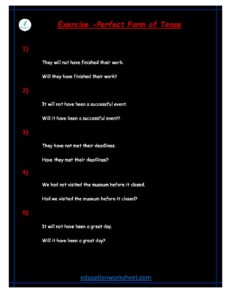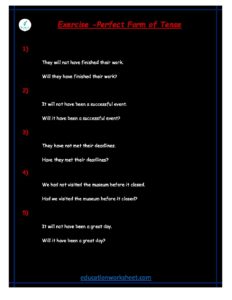changing Perfect Tense to negative and interrogative
changing Perfect Tense to negative and interrogative
The Basics of the Perfect Tense:
Before we dive into changing Perfect Tense into negative and interrogative forms, let’s ensure we have a solid grasp of the basic structure of the Perfect Tense. The Perfect Tense is formed by combining the auxiliary verb “have” (in various forms: have, has, or had) with the past participle of the main verb. The result is a structure that indicates an action or state that has been completed in relation to the present moment or with relevance to a specific point in time.
For example:
- Affirmative: She has finished her assignment.
- Negative: She has not finished her assignment.
- Interrogative: Has she finished her assignment?
The transformation into negative and interrogative forms involves changing the structure and the placement of words in the sentence. Let’s take a closer look at how to do this.
Converting Perfect Tense into the Negative Form:

To change a sentence from the affirmative Perfect Tense to the negative form, you need to introduce the word “not” after the auxiliary verb “have.” Here are some examples:
- Affirmative: They have eaten lunch.
- Negative: They have not eaten lunch.
- Affirmative: He has visited London before.
- Negative: He has not visited London before.
- Affirmative: We have seen that movie.
- Negative: We have not seen that movie.
As you can see, the insertion of “not” immediately after the auxiliary verb changes the sentence from positive to negative. It is a straightforward transformation that allows us to express the negation of an action or state in the Perfect Tense.
Converting Perfect Tense into the Interrogative Form:

Converting Perfect Tense into the interrogative form is equally straightforward. In this case, we need to switch the positions of the auxiliary verb “have” and the subject of the sentence. Additionally, we need to add a question mark at the end of the sentence to indicate that it is a question. Here are some examples:
- Affirmative: I have finished my work.
- Interrogative: Have I finished my work?
- Affirmative: They have watched the game.
- Interrogative: Have they watched the game?
- Affirmative: She has visited the museum.
- Interrogative: Has she visited the museum?
By changing the position of the auxiliary verb and subject, we transform a positive statement into a question. This is a fundamental structure for asking questions in the Perfect Tense.
Common Mistakes to Avoid:
When transforming Perfect Tense into negative and interrogative forms, it’s important to be aware of some common mistakes and pitfalls that learners often encounter. Here are a few to watch out for:
- Double Negatives: Avoid using double negatives, such as “I haven’t never been there.” The correct form would be “I have never been there.”
- Subject-Auxiliary Agreement: Ensure that the auxiliary verb matches the subject in terms of person and number. For example, “She have finished” is incorrect; it should be “She has finished.”
- Proper Placement of “Not”: Place “not” immediately after the auxiliary verb to form a negative statement. For instance, “She has not seen the movie” is correct, while “She has seen not the movie” is incorrect.
- Question Structure: Be sure to invert the position of the auxiliary verb and the subject when forming questions. “Has she visited the museum?” is correct, while “She has has visited the museum?” is not.
Practical Applications of Negative and Interrogative Perfect Tense:

Understanding how to transform Perfect Tense into negative and interrogative forms is not only about mastering the rules; it’s also about knowing when and how to use these structures effectively. Let’s explore some practical scenarios in which these variations are useful:
- Negative Perfect Tense:
- Expressing Prohibition: “You have been told not to touch that.”
- Indicating Absence of an Action: “They have not received the email yet.”
- Denying a Past Action: “She has not met the new boss.”
- Interrogative Perfect Tense:
- Seeking Information: “Have you seen my keys?”
- Clarifying Doubts: “Has he finished the report?”
- Making Polite Requests: “Could you have it ready by tomorrow?”
Advanced Usage: Time Expressions and Perfect Tense:
Perfect Tense can also be modified to express different time frames by using various time expressions. These time expressions can be effectively integrated into both negative and interrogative forms of the Perfect Tense.
- Affirmative: She has visited the museum.
- Negative: She has not visited the museum yet.
- Interrogative: Has she visited the museum before?
In the negative form, the addition of “yet” indicates that the action may still occur in the future. In the interrogative form, “before” specifies a past time frame.
The Role of Adverbs in Perfect Tense:
Adverbs play a crucial role in the Perfect Tense, whether in negative or interrogative form. They can provide additional information about the action or state in question. For example:
- Affirmative: They have already completed the task.
- Negative: They have not yet completed the task.
- Interrogative: Have they already completed the task?
Adverbs like “already” and “yet” enhance the meaning and context of the sentence, indicating when the action occurred or may occur.

